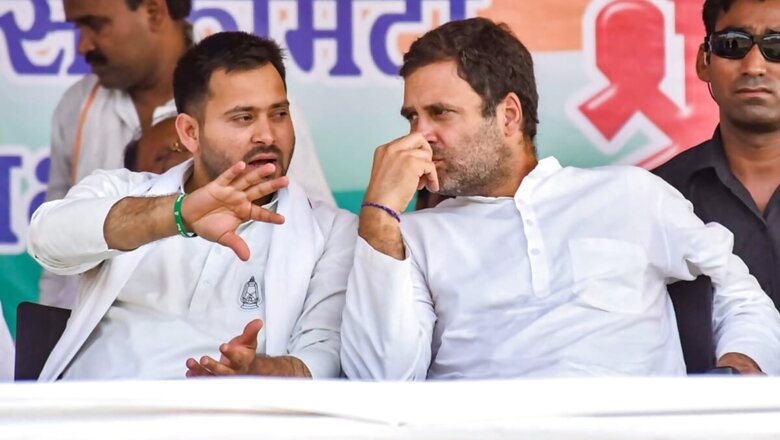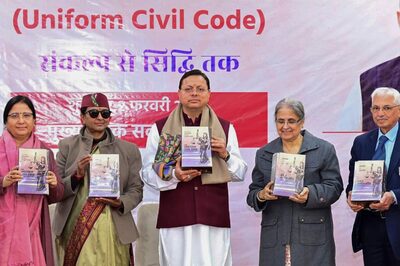
views
Political parties had started to ramp up their organisation machinery in preparations for 2012 Uttar Pradesh assembly polls. The then Samajwadi Party state chief Akhilesh Yadav in starch-white kurta-pyjama and red cap was peddling his way through the state to mobilise support against Mayawati government. Congress having tasted success in 2009 Lok Sabha polls was breathing down the neck — seeking to wean away minority votes.
In the midst of all this, Mulayam’s close aide and Deoria MP Mohan Singh met Rampur strongman Azam Khan and announced support for the induction of DP Yadav, the dreaded don from western UP.
Akhilesh Yadav was said to have spoken to his father against any such move. Mohan Singh was removed as party spokesperson to send across a message that the likes of DP Yadav were no more welcome in the party.
The image makeover was full and final. People were convinced that SP under Akhilesh had turned a new leaf. Samajwadi Party won the elections by a thumping majority. Akhilesh Yadav got 75 seats more than SP’s best ever performance under the patriarch. The rest is history.
Every election invariably entails social-political churning, where communities and social groups align or break up to stitch new alliance and maximise their share in the power pie. Amidst the mumble-jumble of campaign where all participants want to be heard and believed, there is this but one defining moment which tends to set the house in order. Like the judge’s gavel in a courtroom commotion. Like a drop of reagent falling off the tip of a pipette to crystallises a new compound in a swirling flask.
The Raja of Manda during the 1989 election campaign would pull out a chit from his pocket on which he claimed were scribbled Swiss Bank account details of beneficiaries of the Bofors scam. People believed him and voted to catapult Singh as the second non-Congress Prime Minister of India.
The electoral history of contemporary Indian politics is strewn with such examples. Former UP chief minster Kalyan Singh called Raja Bhaiyya ‘Kunda ka Gunda’ in an election rally to bolster his credentials as a no-nonsense leader with zero tolerance for Bahubalis. Sensing huge anti-incumbency against SP government, Mayawati promised to send the duo of Mulayam and Amar Singh behind bars if she were to win 2007 UP assembly polls.
In 2020, not many people would have given Tejashwi Yadav an iota of a chance to challenge the might of NDA.
To his credit, Tejaswi picked up just the right issues to set the agenda for Bihar 2020. He needed to get votes over and above Yadav and Muslim electorate. The first phase of the RJD campaign worked to knit disparate groups which may have suffered during the recent floods and pandemic.
‘Gareeb pareshan ho gaya’ became the common refrain. Gareebi is a social-construct which creates the broadest possible coalition in electoral politics. It overrides castes fragmentations. Like Indira Gandhi’s gareebi-hatao. It encompasses all sub-altern castes which are numerically substantial. Dalits, maha-dalits, extremely backward castes, minorities, even poor among the upper castes or anyone who has been hit by the economic downturn seeks to identify with the theme.
Tejaswi Yadav in this election sought to create most inclusive coalition. Straight out of Hemant Soren’s playbook in Jharkhand, Tejashwi Yadav did not waste seats in smaller parties which had failed to deliver in the past or could have defected to the other side in case of a close finish.
Instead, RJD put in its efforts to accommodate Congress to consolidate minorities. Mahagathbadhan gave 19 seats to CPI(ML) as it has demonstrated its ability to transfer cadre votes of the landless labourers it has been working to mobilise.
This was followed by epiphany of the promise of ’10 lakh government jobs’. Sarkari naukari and not just naukari which still holds a great lure in the heartland. The target was 65 lakh first time voters; or the millennials who nurture no memories whatsoever of the Lalu-Rabri Raj.
He hopped, skipped and jumped past landmines laid down the path during the campaign; ducking any queries that had the potential to bring Pakistan as a talking point in Bihar polls by doggedly dragging the discourse back to kamai, padhai, davai and sinchai.
And yet the young RJD leaders seems to have failed to deliver the final knock-out punch to Nitish Kumar. There are two factors which may have led to the MGB shortfall.
People heard him. They agreed with all he said. But perhaps, unlike Akhilesh Yadav in 2012, Tejashwi could not convince just enough people to complete the ensemble.
The memories of 15 years of RJD rule seems to have had a lingering undertone. Just enough to hold back the aged and the elderly in endorsing the children seeking badlav.
Post polls surveys on TV channels may have given a clear edge to the MGB, data collected by party pollsters showed Bihar 2020 would be a very close race.
In retrospect, as political observers look back, they seem to have missed or under-sampled the WOW factor this election. WOMEN, who seems to have voted for security over everything else. And OWAISI who not only won five seats but damaged MGB in many more in the Seemanchal region. High voter turnout in the third phase was being taken by some as consolidation of minority votes for the RJD and Congress. Asaduddin Owaisi’s MIM seems to have done enough damage to stop the MGB well short of the half way mark.
RJD emerged as the single largest party in terms of votes and seats. But to win this election, RJD as the biggest partner in MGB had to secure upward of 85 seats. They fell short by 10.
The 2020 election has to a large extent settled the leadership issues in the non-NDA ranks and file in Bihar. The race on the other side of the fence is wide open.
Read all the Latest News, Breaking News and Coronavirus News here




















Comments
0 comment